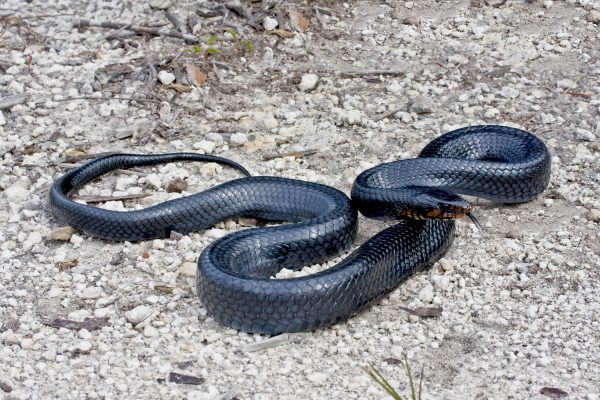They seem similar at first glance, but it turns out the indigo snakes found on Florida’s Atlantic and Gulf coasts are not two of a kind.

Florida Museum photo by Kenneth L. Krysko
Ten years of research by Florida Museum of Natural History scientists led to new information about the origins of Florida’s largest native snake species, which may impact efforts by the Florida Fish and Wildlife Conservation Commission to conserve the reptiles and their environments.
Museum researchers confirmed that two distinct lineages of indigo snakes live on opposite sides of Florida. Differences in the genetics and appearances of the Gulf Coast and Atlantic snake populations resulted in the new description of the Gulf Coast indigo snake, Drymarchon kolpobasileus, meaning “Gulf King”—a reference to it being the largest native snake on Florida’s Gulf Coast.
The findings are discussed in two new studies appearing online in the journals Zootaxa and Molecular Phylogenetics and Evolution.
Understanding the differences between the two lineages has the potential to improve biodiversity conservation efforts that might otherwise inadvertently harm the snakes, said lead author Kenneth Krysko, herpetology collection manager at the Florida Museum on the University of Florida campus.
“The indigo snake is important for research because it is a state and federally threatened species, and the state is considering a conservation practice called translocation where indigo snakes are reintroduced back into areas where they once occurred,” Krysko said.
In the case of the indigo snakes, it could harm populations if the wrong species is introduced, Krysko said.
“It is important to reintroduce the correct lineage of indigos into certain areas, not only to conserve natural genetic diversity but also ensure that we are not introducing a different species,” Krysko said.
Gulf Coast indigos live from the Florida Keys northward into the western Florida Panhandle, while the Atlantic species lives along the Atlantic Coast from around Indian River County northward to southeastern Georgia.
The two snake species diverged from each other around 2 million years ago as a result of historic sea level changes in Florida, at times resulting in a series of saltwater islands. Because these island snakes were separated from other populations, they evolved independently, Krysko said.
Study researchers were able to discern the two lineages by studying their DNA, said co-author Leroy Nuñez, a Florida Museum herpetology collections assistant and UF interdisciplinary ecology master’s student.
“It’s very likely that they’ve come into contact with one another many times since their initial divergence,” Nuñez said. “But they’re still two distinct lineages.”
Physical differences have also been found between the Gulf Coast and Atlantic indigos. The Gulf Coast snake has a slightly smaller, shallower head and certain smaller facial scales than the Atlantic species, Nuñez said.
Read the study online at Zootaxa.
Learn more about Herpetology at the Florida Museum.